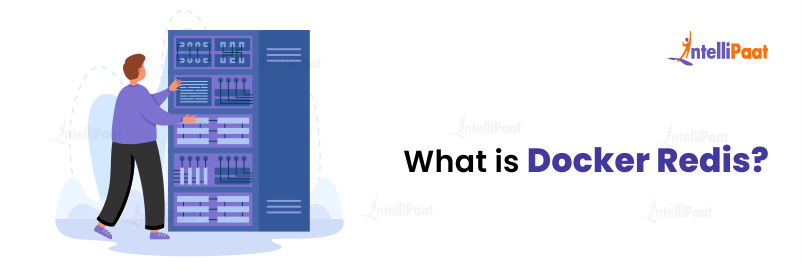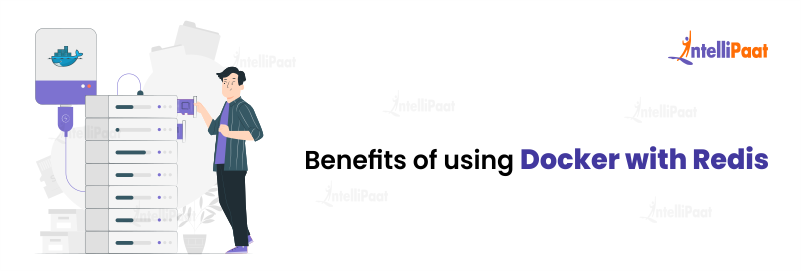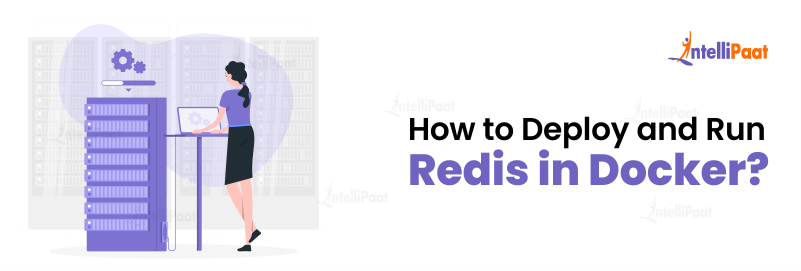What is Docker Redis? How to start and Deploy it?
In modern software development and deployment, Docker has emerged as a revolutionary technology that enables the creation and management of lightweight, portable containers.
On the other hand, Redis is a high-performance, in-memory data structure store known for its exceptional speed and versatility. When these two powerhouses come together, they create a formidable combination—Docker Redis. This blog will explore the fundamentals of Docker Redis and how to deploy and run it effortlessly.
- What is Docker Redis?
- Benefits of Using Docker with Redis
- How to Deploy and Run Redis in Docker?
- Conclusion
Kindly go through our Docker Course video in order to get a better understanding:
{
“@context”: “https://schema.org”,
“@type”: “VideoObject”,
“name”: “Docker Training | Docker Tutorial for Beginners | What is Docker | Intellipaat”,
“description”: “What is Docker Redis? How to start and Deploy it?”,
“thumbnailUrl”: “https://img.youtube.com/vi/RppfZGuLsmA/hqdefault.jpg”,
“uploadDate”: “2023-07-14T08:00:00+08:00”,
“publisher”: {
“@type”: “Organization”,
“name”: “Intellipaat Software Solutions Pvt Ltd”,
“logo”: {
“@type”: “ImageObject”,
“url”: “https://intellipaat.com/blog/wp-content/themes/intellipaat-blog-new/images/logo.png”,
“width”: 124,
“height”: 43
}
},
“embedUrl”: “https://www.youtube.com/embed/RppfZGuLsmA”
}
What is Docker Redis?

Redis is a fast and flexible in-memory data structure store with immense popularity among developers. On the other hand, Docker is a containerization platform that allows for easy deployment and management of applications.
Docker Redis integrates these two technologies, offering a seamless way to run Redis inside Docker containers. By encapsulating Redis within a Docker container, developers can enjoy the benefits of containerization, such as portability, scalability, and isolation. In addition, they can leverage Redis’ speed and versatility of Redis.
Docker Redis provides an efficient solution for managing data-intensive applications and simplifies the process of deploying and running Redis instances across different environments.
Want to know more about Docker in detail, enroll in Docker Certification Training Course!
Benefits of using Docker with Redis

Docker Redis brings numerous benefits and revolutionizes how we deploy and manage Redis instances.
Here are some key advantages of using Docker in combination with Redis:
- Portability and Scalability- Docker allows you to package your Redis instance and its dependencies into a lightweight, portable container. This container can then be easily deployed across different environments, ensuring consistent behavior and eliminating the hassles of manual configuration.
- Resource Optimization- With Docker, you can efficiently utilize system resources by running multiple Redis containers on a single host machine. Docker’s containerization ensures isolation and prevents resource conflicts, enabling optimal CPU, memory, and network utilization.
- Simplified Deployment- Docker simplifies the deployment process by providing a standardized and reproducible environment. You can easily define and manage complex Redis deployments, including replication, sharding, and failover mechanisms with Docker Compose or orchestration tools like Kubernetes.
- Enhanced Security- Docker’s containerization provides additional security for your Redis instances. Containers isolate processes and prevent direct access to the host system, reducing the risk of data breaches or unauthorized access.
- Rapid Development and Testing- Docker’s ability to build isolated containers makes it simple to set up several Redis instances for development, testing, and debugging. Developers can instantly set up Redis containers to replicate different situations while working in a consistent environment.
- Versioning and Rollbacks- Docker enables version control for your Redis deployments. You can tag and manage different versions of your Redis container images, facilitating easy rollbacks in case of issues or performance regressions.
Take your development environment to the next level with Docker. Follow our step-by-step Docker Tutorial to get started!
How to Deploy and Run Redis in Docker?

Here’s a step-by-step guide on how to deploy and run Redis in Docker:
Step 1: Install Docker
Ensure that Docker is installed on your system before proceeding. Docker offers installation packages for various operating systems like Windows, macOS, and Linux. Visit the official Docker website and follow the installation instructions specific to your operating system.
Step 2: Pull the Redis Docker Image
After installing Docker, you must obtain the Redis Docker image from the Docker Hub repository. After opening the terminal or command prompt execute the following command:
docker pull redis
This command downloads the latest Redis image and saves it on your local machine.
Step 3: Create a Redis Container
You must run the Redis image using the ‘docker run’ command to create a Redis container. Open a terminal or command prompt and execute the following command:
docker run --name my-redis-container -p 6379:6379 -d redis
Here’s what the command does:
- ‘–name my-redis-container’: Assign a name to the container and choose any name you prefer.
- ‘-p 6379:6379’: Maps the Redis container’s port (6379) to the host machine’s Redis port (also 6379). This allows you to access Redis from your host machine.
- ‘-d redis’: Runs the Redis image in detached mode, meaning it operates in the background.
Upon executing the command, Docker creates a new Redis container, which starts running based on the Redis image.
Step 4: Interacting with Redis
With the Redis container up and running, you can interact with it using Redis clients or command-line tools. Numerous Redis clients, such as Redis CLI, Redisson, and Redli, are available.
For example, if you have Redis CLI installed on your host machine, open a new terminal or command prompt and execute the following command to connect to the Redis container:
redis-cli
This command opens the Redis CLI prompt, enabling you to execute Redis commands. To illustrate, you can set a key-value pair using the ‘SET’ command:
SET mykey "Hello, Redis!"
To retrieve the value, employ the ‘GET’ command:
GET mykey
Upon executing the command, you should observe the output “Hello, Redis!”
Step 5: Stopping and Removing the Redis Container
You can stop and remove the Redis container when you no longer require it. Open a terminal or command prompt and execute the following commands:
docker stop my-redis-container
docker rm my-redis-container
The first command (‘docker stop’) stops the running container, and the second command (‘docker rm’) removes the container from your system.
That’s it! You have now successfully learned how to deploy and run Redis in Docker.
Want to excel in your interview? Refer to our Top Docker Interview Questions and Answers!
Conclusion
In conclusion, Docker Redis is a valuable tool that combines Docker and Redis, offering a range of benefits to developers and businesses. Leveraging Docker’s containerization capabilities with Redis’s high-performance data storage and caching, Docker Redis simplifies deployment, enhances scalability, and streamlines development workflows.
Following a few straightforward steps discussed earlier in this blog, users can easily deploy and run Redis in Docker, creating isolated and reproducible environments.
This beginner-friendly approach enables learners to quickly grasp the concepts and implement Docker Redis efficiently, empowering them to optimize their applications and maximize productivity.
Still in doubt? Contact us at our Community Page!
The post What is Docker Redis? How to start and Deploy it? appeared first on Intellipaat Blog.
Blog: Intellipaat - Blog
Leave a Comment
You must be logged in to post a comment.







